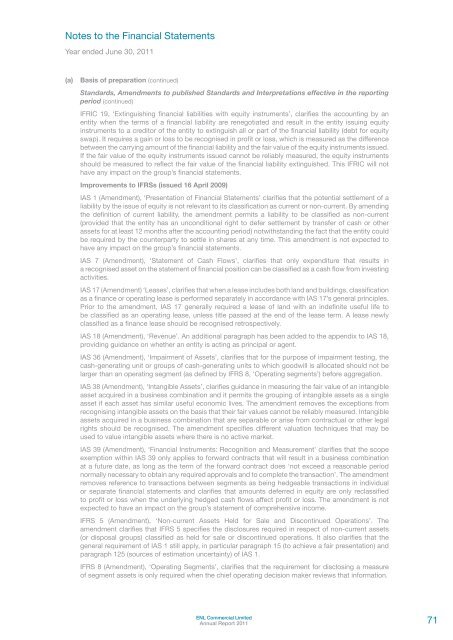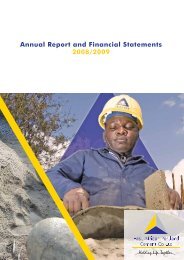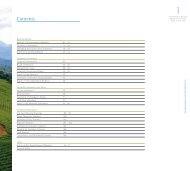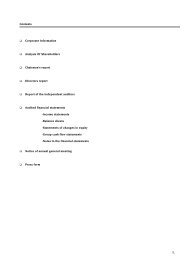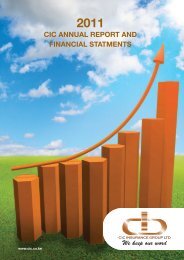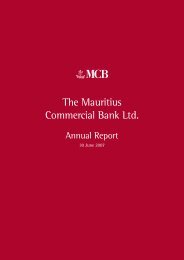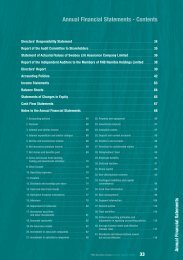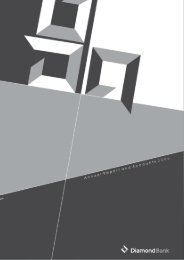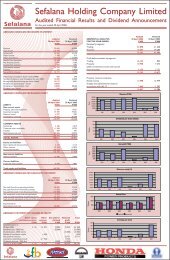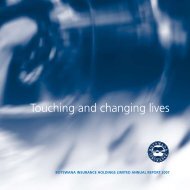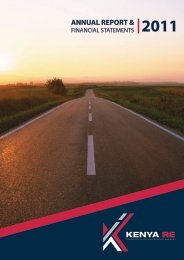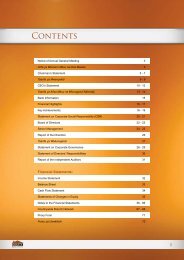enl commercial limited annual report 2011 - Investing In Africa
enl commercial limited annual report 2011 - Investing In Africa
enl commercial limited annual report 2011 - Investing In Africa
You also want an ePaper? Increase the reach of your titles
YUMPU automatically turns print PDFs into web optimized ePapers that Google loves.
Notes to the Financial Statements<br />
Year ended June 30, <strong>2011</strong><br />
(a)<br />
Basis of preparation (continued)<br />
Standards, Amendments to published Standards and <strong>In</strong>terpretations effective in the <strong>report</strong>ing<br />
period (continued)<br />
IFRIC 19, ‘Extinguishing financial liabilities with equity instruments’, clarifies the accounting by an<br />
entity when the terms of a financial liability are renegotiated and result in the entity issuing equity<br />
instruments to a creditor of the entity to extinguish all or part of the financial liability (debt for equity<br />
swap). It requires a gain or loss to be recognised in profit or loss, which is measured as the difference<br />
between the carrying amount of the financial liability and the fair value of the equity instruments issued.<br />
If the fair value of the equity instruments issued cannot be reliably measured, the equity instruments<br />
should be measured to reflect the fair value of the financial liability extinguished. This IFRIC will not<br />
have any impact on the group’s financial statements.<br />
Improvements to IFRSs (issued 16 April 2009)<br />
IAS 1 (Amendment), ‘Presentation of Financial Statements’ clarifies that the potential settlement of a<br />
liability by the issue of equity is not relevant to its classification as current or non-current. By amending<br />
the definition of current liability, the amendment permits a liability to be classified as non-current<br />
(provided that the entity has an unconditional right to defer settlement by transfer of cash or other<br />
assets for at least 12 months after the accounting period) notwithstanding the fact that the entity could<br />
be required by the counterparty to settle in shares at any time. This amendment is not expected to<br />
have any impact on the group’s financial statements.<br />
IAS 7 (Amendment), ‘Statement of Cash Flows’, clarifies that only expenditure that results in<br />
a recognised asset on the statement of financial position can be classified as a cash flow from investing<br />
activities.<br />
IAS 17 (Amendment) ‘Leases’, clarifies that when a lease includes both land and buildings, classification<br />
as a finance or operating lease is performed separately in accordance with IAS 17’s general principles.<br />
Prior to the amendment, IAS 17 generally required a lease of land with an indefinite useful life to<br />
be classified as an operating lease, unless title passed at the end of the lease term. A lease newly<br />
classified as a finance lease should be recognised retrospectively.<br />
IAS 18 (Amendment), ‘Revenue’. An additional paragraph has been added to the appendix to IAS 18,<br />
providing guidance on whether an entity is acting as principal or agent.<br />
IAS 36 (Amendment), ‘Impairment of Assets’, clarifies that for the purpose of impairment testing, the<br />
cash-generating unit or groups of cash-generating units to which goodwill is allocated should not be<br />
larger than an operating segment (as defined by IFRS 8, ‘Operating segments’) before aggregation.<br />
IAS 38 (Amendment), ‘<strong>In</strong>tangible Assets’, clarifies guidance in measuring the fair value of an intangible<br />
asset acquired in a business combination and it permits the grouping of intangible assets as a single<br />
asset if each asset has similar useful economic lives. The amendment removes the exceptions from<br />
recognising intangible assets on the basis that their fair values cannot be reliably measured. <strong>In</strong>tangible<br />
assets acquired in a business combination that are separable or arise from contractual or other legal<br />
rights should be recognised. The amendment specifies different valuation techniques that may be<br />
used to value intangible assets where there is no active market.<br />
IAS 39 (Amendment), ‘Financial <strong>In</strong>struments: Recognition and Measurement’ clarifies that the scope<br />
exemption within IAS 39 only applies to forward contracts that will result in a business combination<br />
at a future date, as long as the term of the forward contract does ‘not exceed a reasonable period<br />
normally necessary to obtain any required approvals and to complete the transaction’. The amendment<br />
removes reference to transactions between segments as being hedgeable transactions in individual<br />
or separate financial statements and clarifies that amounts deferred in equity are only reclassified<br />
to profit or loss when the underlying hedged cash flows affect profit or loss. The amendment is not<br />
expected to have an impact on the group’s statement of comprehensive income.<br />
IFRS 5 (Amendment), ‘Non-current Assets Held for Sale and Discontinued Operations’. The<br />
amendment clarifies that IFRS 5 specifies the disclosures required in respect of non-current assets<br />
(or disposal groups) classified as held for sale or discontinued operations. It also clarifies that the<br />
general requirement of IAS 1 still apply, in particular paragraph 15 (to achieve a fair presentation) and<br />
paragraph 125 (sources of estimation uncertainty) of IAS 1.<br />
IFRS 8 (Amendment), ‘Operating Segments’, clarifies that the requirement for disclosing a measure<br />
of segment assets is only required when the chief operating decision maker reviews that information.<br />
ENL Commercial Limited<br />
Annual Report <strong>2011</strong><br />
71


